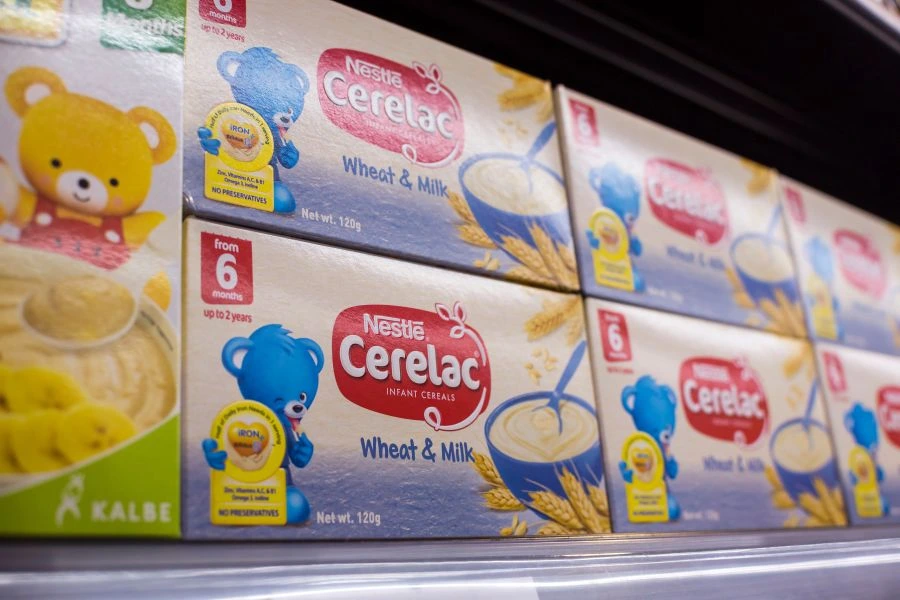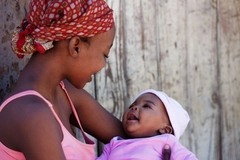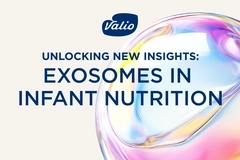Nestlé fires back at accusation of adding sugar to infant cereal in Africa
Key takeaways
- Nestlé dismisses Public Eye’s findings of added sugar content in its infant cereal brands Cerelac and Nestum sold in Africa.
- The NGO’s investigations found that Cerelac products contained an average of nearly 6 g of added sugar per serving.
- Nestlé argues the products meet Codex regulations, but Public Eye contends the company voluntarily removed added sugar in Europe.
Nestlé has disputed accusations by the NGO Public Eye that its infant cereals sold in Africa feature added sugar. Recent reports by the NGO claim the Swiss nutritional company’s brands Cerelac and Nestum sold in Africa contain added sugar, while the same products on the European market are refined-sugar free.
“We disagree with this report as it contains misleading and unfounded allegations,” a Nestlé spokesperson tells Nutrition Insight.
“We do not have double standards; our approach to nutrition is consistent across all countries. We treat all children equally, regardless of where they are. The health and nutrition of children globally is our utmost priority, and we focus on offering parents healthy choices everywhere we sell our products.”
The company states that it has requested further details of Public Eye’s product analyses and methodologies, but has not yet received these.
Last year, the Swiss company also disputed Public Eye’s accusations of adding sugar to infant nutrition sold in lower-income countries, asserting that it had reduced the total amount of added sugar in its global infant cereal products by 11%.
“This is already our second investigation on the topic,” Laurent Gaberell, lead author of the new reports and food and agriculture expert at Public Eye, tells us.

Gaberell explains that the most recent report aimed to monitor Nestlé’s actions in infant nutrition. “In India, after the last investigation, Nestlé announced that it would replace its entire portfolio. But we wanted to see what happened in Africa.”
“We found that nothing had changed. Nestlé keeps adding dangerous levels of sugar to the vast majority of its products. We will keep doing these kinds of investigations in the future, to keep Nestlé accountable.”
Public Eye reports
The Swiss NGO published two reports on Nestlé’s infant cereal offerings in Africa, drawing on insights from a field trip in South Africa and contributions from partner organizations.
 Public Eye partners bought Cerelac products in Africa, which were analyzed for their sugar content, focusing on sucrose and honey. Gaberell says that for the first report, Public Eye went to the Eastern Cape region to interview mothers who are using Nestlé products. “We talked to doctors and health experts about the public health consequences.”
Public Eye partners bought Cerelac products in Africa, which were analyzed for their sugar content, focusing on sucrose and honey. Gaberell says that for the first report, Public Eye went to the Eastern Cape region to interview mothers who are using Nestlé products. “We talked to doctors and health experts about the public health consequences.”
The NGO claims that Nestum infant cereal sold in South Africa for babies aged six months and older contained elevated quantities of added sugar — “more than 2 g per serving.”
Public Eye’s second investigation focused on added sugar in Cerelac infant cereals sold in various African countries.
“We have worked with partner organizations in 20 countries,” says Gaberell. “We asked them to visit a couple of leading supermarkets, purchase all the Cerelac products they could find, and send them to us in Switzerland.”
“We then got them analyzed by Inovalys, a leading public laboratory based in France, specialized in such analysis. The lab performed a full sugar analysis, but we only took the amount of sucrose and honey and excluded natural sugars coming from the milk, fruits, and cereals.”
According to the laboratory, each analyzed serving of Cerelac contained nearly 6 g of added sugar, 50% more than the average found in Public Eye’s 2024 investigation of products sold in Asia and Latin America. Cerelac products sold in Burundi contained the highest average level of added sugar (7.3 g per serving), and those in South Africa contained the lowest average (3.6 g).
In addition, Public Eye notes that most of the products without added sugar the team found were “not intended by Nestlé for the African market but imported from Europe by other actors.”
“Added” sugar?
Nestlé details that if sugars coming from ingredients such as milk, cereals, and fruits are excluded from its Cerelac infant cereals’ content, they “do not contain the levels of added refined sugars mentioned in the report.”
“It is misleading and scientifically inaccurate to refer to the sugars coming from the cereals and naturally present in fruits as refined sugars added to the products,” the spokesperson tells us.
“The levels of all types of added sugars in our infant cereals are well below those set by the international food standards body, Codex Alimentarius. We apply our threshold everywhere.”
Moreover, the company maintains that the product composition and on-pack declarations are fully aligned with the standards set by local regulatory authorities.
 Nestlé states that if sugars from milk, cereals, and fruits are excluded, Cerelac products do not contain the reported levels of added refined sugars.“The sugar content declared on our product packaging is based on rigorous assessments, including the use of reliable analytical methods by certified laboratories,” says the company.
Nestlé states that if sugars from milk, cereals, and fruits are excluded, Cerelac products do not contain the reported levels of added refined sugars.“The sugar content declared on our product packaging is based on rigorous assessments, including the use of reliable analytical methods by certified laboratories,” says the company.
Gaberell details that regulations in Africa, Switzerland, and the EU are “basically the same,” and based on the Codex Alimentarius standards. These allow for some added sugar in baby foods — the standard for baby cereals like Cerelac would be 30% of added sugar.
“This is the limit that you will find in legislation across African countries, but we do have the same limit in the EU and Switzerland,” he reiterates.
“In other words: Nestlé is allowed to add sugar here in Europe, but they decided to remove it, probably because they understood that consumers do not want added sugar in the foods they give to their babies. But they keep adding in Africa because they think that consumers in these countries are not aware and do not care.”
Rigorous principles
Nestlé states that it offers variants “with and without added sugars” positioned in the same price range in Africa and Europe.
“We hold ourselves accountable to the same rigorous principles globally,” according to Nestlé’s spokesperson.
“We are accelerating the rollout of no-added-sugar variants globally, which are already present in 97% of our Nestlé markets, including in Africa in the three regions where we operate — North, Central and West, and Southern and Eastern Africa — and we aim to reach 100% by the end of 2025.”
Gaberell argues that Nestlé is well aware of the risks of added sugar to infants’ health. “ The company knows how to do better. Nestlé just took a deliberate decision to feed African babies with fewer health options.”
He calls on the company: “Remove added sugar from all your baby food products, everywhere in the world.”
Gaberell notes that a joint open letter signed by 20 African organizations from 13 different countries was sent to Nestlé with this demand on November 17.
















